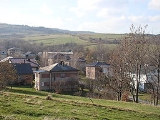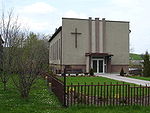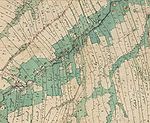
Wola Piotrowa
Encyclopedia


Lesser Poland
Lesser Poland is one of the historical regions of Poland, with its capital in the city of Kraków. It forms the southeastern corner of the country, and should not be confused with the modern Lesser Poland Voivodeship, which covers only a small, southern part of Lesser Poland...
in the Bukowsko Upland
Pogórze Bukowskie
The Pogórze Bukowskie is one of the Beskids mountain ranges of the Outer Eastern Carpathians in southeastern Poland, part of the Central Beskidian Piedmont...
mountains, Bukowsko
Bukowsko
Bukowsko is a village in Sanok County, Subcarpathian Voivodeship, Poland. It's in the Bukowsko Upland mountains, parish in loco, located near the towns of Medzilaborce and Palota . During the Polish–Lithuanian Commonwealth it was in Lesser Poland prowincja.-Characteristics:Bukowsko is the...
rural commune, Latin parish in Bukowsko
Bukowsko
Bukowsko is a village in Sanok County, Subcarpathian Voivodeship, Poland. It's in the Bukowsko Upland mountains, parish in loco, located near the towns of Medzilaborce and Palota . During the Polish–Lithuanian Commonwealth it was in Lesser Poland prowincja.-Characteristics:Bukowsko is the...
, protestant parish in loco.
Wola Piotrowa is about 17 miles from the city of Sanok
Sanok
Sanok is a town in south-eastern Poland with 39,110 inhabitants, as of 2 June 2009. It's the capital of Sanok County in the Subcarpathian Voivodeship. Previously, it was in the Krosno Voivodeship and in the Ruthenian Voivodeship , which was part of the Lesser Poland province...
in southeast Poland. It is situated below the main watershed at the foot of the Słonne Mountain
Carpathian Mountains
The Carpathian Mountains or Carpathians are a range of mountains forming an arc roughly long across Central and Eastern Europe, making them the second-longest mountain range in Europe...
, and has an elevation of 340 metres. Situated in the Subcarpathian Voivodship (since 1999), previously in Krosno Voivodship (1975-1998) and Sanok
Sanok
Sanok is a town in south-eastern Poland with 39,110 inhabitants, as of 2 June 2009. It's the capital of Sanok County in the Subcarpathian Voivodeship. Previously, it was in the Krosno Voivodeship and in the Ruthenian Voivodeship , which was part of the Lesser Poland province...
district, (10 miles east of Sanok), located near the towns of Medzilaborce
Medzilaborce
Medzilaborce is a town in northeastern Slovakia close to the border with Poland, located near the towns of Sanok and Bukowsko . Its population is approximately 6,600.-Characteristics:...
and Palota
Palota
Palota is a village and municipality in the Medzilaborce District in the Prešov Region of far north-eastern Slovakia.-Geography:The municipality lies at an altitude of 482 metres and covers an area of 24.116 km². It has a population of about 190 people....
(in northeastern Slovakia). Wola Piotrowa was founded in 1526 by Herburts family. From 966-1018, 1340- 1772 (Ruthenian Voivodeship
Ruthenian Voivodeship
Ruthenia Voivodeship was an administrative division of the Kingdom of Poland . Together with Bełz Voivodeship, it formed Lesser Poland Province with its capital city in Kraków. Part of Lesser Poland region...
, Sanok Land
Sanok Land
Sanok Land was a historical administrative division unit of the Polish-Lithuanian Commonwealth from the 14th-18th centuries. It consisted of land that now belongs to the powiats of: Sanok, Brzozów, Lesko and partially Krosno and Rzeszów.Ziemia Sanocka was a part of the Ruthenian Voivodeship ...
) and from 1918-1939 Wola was part of Poland
Poland
Poland , officially the Republic of Poland , is a country in Central Europe bordered by Germany to the west; the Czech Republic and Slovakia to the south; Ukraine, Belarus and Lithuania to the east; and the Baltic Sea and Kaliningrad Oblast, a Russian exclave, to the north...
. While during 1772-1918 it belonged to Austrian empire, it later became part of the Austrian-Hungarian dual crown monarchy . This territory fell under the control of the Austro-Hungarian Empire for almost 120 years. At that time the area (including west and east of Subcarpathian Voivodship) was known as Galicia. In 1785, the village lands comprised 6 1 lan. In 1899 the village lands comprised 3.43 km². The cemetery has approximately a half-dozen visible headstones left in it. The rural families are poor, agriculture is rarely profitable and low income makes it difficult for farmers to invest in agricultural mechanization and other improvements.
Wola Piotrowa and the Expulsion Operations of 1945-1946:
Prior to 1946, this village was primarily inhabited by Lemkos, and a Greek Catholic church existed in the village (a filial church to the larger Ukrainian/Greek Catholic parish in Karlykiv/Karlikow. Prior to the expulsion of Lemkos/Ukrainians from the village and the destruction of the Greek Catholic church, Oleksiy Malarchyk was the priest in charge of Karlykiv (Karlikow), Prybyshchiv (Przybyzow) and Vola Petrova (Wola Piotrowa.) The history of Wola Piotrowa is inextricably linked to long-standing Polish/Ukrainian ethnic disputes over the territories of Galicia and Volhynia. Soviet and Polish communist collaborators were responsible for population exchanges that occurred between 1944 and 1947. Those population exchanges, which were intended to achieve an ethnically cleansed post-war order in the expanded Soviet Union and in Poland, included the forcible expatriation of ethnic Ukrainians from Wola Piotrowa and other villages in Galicia, and the deportation of ethnic Poles from the former kresy lands which became part of Soviet Ukraine. After the final expulsion of ethnic Ukrainians in Wola Piotrowa in 1946 (the mass expulsions and burning of this village pre-dated Operation Vistula, although its possible that some Lemkos remained until the 1947 operation), Polish communists burned down this village (and many others) likely for the purpose of deterring the expelled Lemkos from "illegally" resettling in the village. [NOTE: Despite some claims that these lands were burned by the Ukrainian Insurgent Army (UPA), several firsthand eyewitnesses to the events have provided oral testimonies that state that it was in fact Polish communists who burned the village during the actual deportation actions.]
Many of the homes that stand in Wola Piotrowa today are built on the foundations of the homes that once stood there, and are mostly inhabited by Poles. The Greek Catholic church that was located in the village is no longer there and a Seventh Day Adventist church is now located in the village, complete with a Seventh Day Adventist cemetery that is adjacent to an old Lemko cemetery at the beginning of the village.
Most popular surnames in the region
Fedor Volianskyj, Tomko Selimka, Michael Chrobaczek, Peter Ścieranka, Hryć Ilciów, Iwan Stefura, Hryć Mega, Łukasz Sałak, Dmytro Wengryn, Fedko Borys, Jan Chrząszcz, Michał Hawryło, Jacko Hawryło, Jacko Pisik, Iwan Białoruski, Michał Labant, Iwan Labant, Sawka Labant, Michał Ścieranka, Salka Ścieranka, Matwij Rusienczak, Stefan Pituch, Michał Romański, Iwan Ścieranka, Matwij Duduś, Matwij Labant, Danko Sadowski, Jacko Bawolak, Anton Kotecki, Andreas Stefura, Andreas Gymak, Iwan Ścieranka, Danko Pituch, Jan Chrząszcz, Iwan Mielnik, Roman Sałak, Iwan Labant, Leśko Sałak, Semko Wołczek, Andreas Czornenki, Iwan Czernenki, Leszko Ostafij, Tymko Król, Iwan Demian, Iwan Król, Lucja Gniewosz (51nr), Iwan Pituch, Tymko Walecki, Herschko Peltz.For more information on Lemko surnames and their origins, see Prof. Ivan Krasovsky's "Surnames of Galician Lemkos in the 17th Century."
Twin cities
- TopoľovkaTopolovkaTopoľovka is a village and municipality in Humenné District in the Prešov Region of north-east Slovakia.-Geography:The municipality lies at an altitude of 157 metres and covers an area of 7.777 km².It has a population of about 825 people.-External links:...
- Maizières-lès-MetzMaizières-lès-MetzMaizières-lès-Metz is a commune in the Moselle department in Lorraine in north-eastern France.It was the original home of the German de Maizière family which, being Huguenots, had to emigrate from France to Prussia in the 17th century...
- Time zone; UTC+1UTC+1UTC+01:00 is an identifier for a time offset from UTC of +01:00. In ISO 8601 the associated time would be written as .This time is used in:*Central European Time*West Africa Time*Western European Summer Time**British Summer Time**Irish Standard Time...
/SummerUTC+2UTC+2UTC+02 is an identifier for a time offset from UTC of +02. In ISO 8601 the associated time would be written as . This time is used in:-Central Africa Time:*Botswana*Burundi*Democratic Republic of the Congo...
Literature
- Prof. Adam FastnachtAdam FastnachtAdam Fastnacht doctor hab., historian, editor . He was a distinguished a Polish historian, researcher of the history of the town and the district of Sanok Land, one of the most renowned Polish historians of his time. Adam Fastnacht was born 1913, in Sanok to a German family who setteled in the east...
. Slownik Historyczno-Geograficzny Ziemi Sanockiej w Średniowieczu (Historic-Geographic Dictionary of the Sanok District in the Middle Ages), Kraków, 2002, ISBN 83-88385-14-3.

